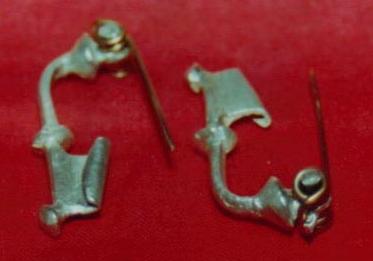Fibula
(cat) |
(cats) |
||
| Line 33: | Line 33: | ||
*''Roman Era in Britain'' by John Ward (1911) Chapter XIV: "[http://penelope.uchicago.edu/Thayer/E/Gazetteer/Places/Europe/Great_Britain/_Periods/Roman/_Texts/WARREB/14*.html Dress and the Toilet]" | *''Roman Era in Britain'' by John Ward (1911) Chapter XIV: "[http://penelope.uchicago.edu/Thayer/E/Gazetteer/Places/Europe/Great_Britain/_Periods/Roman/_Texts/WARREB/14*.html Dress and the Toilet]" | ||
| − | [[Category:Clothing]] | + | [[Category:Roman Clothing]] |
| + | [[Category:Roman Clothing and Equipment]] | ||
Revision as of 04:34, 18 September 2006
A pin or clasp used to in relation to clothing.
Contents |
Forms
The earliest fibulae date from the Iron Age. Fibula styles changed over time and show regional variations. Pins could be hinged or they might be either straight, curved, or wound springs. Fibulae could be plain, engraved, plated, enamelled, or jeweled. Designs might be simple, abstract or zoomorphic. Size varied greatly.
Broadly speaking there were three main types of fibulae: bow, plate and ring.
Bow
This is the "safety pin" shape and all of its variations.
Plate
This is the variety most like the modern "brooch".
Ring
The ring and pin configuration remained popular in the post-Roman period. The ring might be solid (annular) or it might have a gap (penannular).
Use
Although fibulae are often illustrated in the "pin downwards" orientation, this might not have been the norm for fibulae.
Vide
- Roman Era in Britain by John Ward (1911) Chapter XIV: "Dress and the Toilet"

